Animal coloration

Animal colouration is the general appearance of an animal resulting from the reflection or emission of
There are several separate reasons why animals have evolved colours.
Animals produce colour in both direct and indirect ways. Direct production occurs through the presence of visible coloured cells known as pigment which are particles of coloured material such as freckles. Indirect production occurs by virtue of cells known as chromatophores which are pigment-containing cells such as hair follicles. The distribution of the pigment particles in the chromatophores can change under hormonal or neuronal control. For fishes it has been demonstrated that chromatophores may respond directly to environmental stimuli like visible light, UV-radiation, temperature, pH, chemicals, etc.[1] colour change helps individuals in becoming more or less visible and is important in agonistic displays and in camouflage. Some animals, including many butterflies and birds, have microscopic structures in scales, bristles or feathers which give them brilliant iridescent colours. Other animals including squid and some deep-sea fish can produce light, sometimes of different colours. Animals often use two or more of these mechanisms together to produce the colours and effects they need.
History

Animal coloration has been a topic of interest and
In his 1665 book Micrographia, Robert Hooke describes the "fantastical" (structural, not pigment) colours of the Peacock's feathers:[3]
The parts of the Feathers of this glorious Bird appear, through the Microscope, no less gaudy then do the whole Feathers; for, as to the naked eye 'tis evident that the stem or quill of each Feather in the tail sends out multitudes of Lateral branches, ... so each of those threads in the Microscope appears a large long body, consisting of a multitude of bright reflecting parts.
... their upper sides seem to me to consist of a multitude of thin plated bodies, which are exceeding thin, and lie very close together, and thereby, like mother of Pearl shells, do not onely reflect a very brisk light, but tinge that light in a most curious manner; and by means of various positions, in respect of the light, they reflect back now one colour, and then another, and those most vividly. Now, that these colours are onely fantastical ones, that is, such as arise immediately from the refractions of the light, I found by this, that water wetting these colour'd parts, destroy'd their colours, which seem'd to proceed from the alteration of the reflection and refraction.— Robert Hooke[3]
According to
When we see leaf-eating insects green, and bark-feeders mottled-grey; the alpine ptarmigan white in winter, the red-grouse the colour of heather, and the black-grouse that of peaty earth, we must believe that these tints are of service to these birds and insects in preserving them from danger. Grouse, if not destroyed at some period of their lives, would increase in countless numbers; they are known to suffer largely from birds of prey; and hawks are guided by eyesight to their prey, so much so, that on parts of the Continent persons are warned not to keep white pigeons, as being the most liable to destruction. Hence I can see no reason to doubt that natural selection might be most effective in giving the proper colour to each kind of grouse, and in keeping that colour, when once acquired, true and constant.
— Charles Darwin[4]
Henry Walter Bates's 1863 book The Naturalist on the River Amazons describes his extensive studies of the insects in the Amazon basin, and especially the butterflies. He discovered that apparently similar butterflies often belonged to different families, with a harmless species mimicking a poisonous or bitter-tasting species to reduce its chance of being attacked by a predator, in the process now called after him, Batesian mimicry.[5]


Abbott Handerson Thayer's 1909 book Concealing-Coloration in the Animal Kingdom, completed by his son Gerald H. Thayer, argued correctly for the widespread use of crypsis among animals, and in particular described and explained countershading for the first time. However, the Thayers spoilt their case by arguing that camouflage was the sole purpose of animal coloration, which led them to claim that even the brilliant pink plumage of the flamingo or the roseate spoonbill was cryptic—against the momentarily pink sky at dawn or dusk. As a result, the book was mocked by critics including Theodore Roosevelt as having "pushed [the "doctrine" of concealing coloration] to such a fantastic extreme and to include such wild absurdities as to call for the application of common sense thereto."[12][13]
the effect of a disruptive pattern is to break up what is really a continuous surface into what appears to be a number of discontinuous surfaces... which contradict the shape of the body on which they are superimposed.
— Hugh Cott[15]
Animal coloration provided important early evidence for evolution by natural selection, at a time when little direct evidence was available.[16][17][18][19]
Evolutionary reasons for animal coloration
Camouflage
One of the pioneers of research into animal coloration,
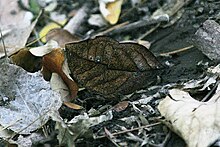
Protective resemblance is used by prey to avoid predation. It includes special protective resemblance, now called mimesis, where the whole animal looks like some other object, for example when a caterpillar resembles a twig or a bird dropping. In general protective resemblance, now called crypsis, the animal's texture blends with the background, for example when a moth's colour and pattern blend in with tree bark.[20]
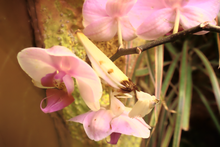
For adventitious protection, an animal uses materials such as twigs, sand, or pieces of shell to conceal its outline, for example when a
In variable protective resemblance, an animal such as a chameleon, flatfish, squid or octopus changes its skin pattern and colour using special chromatophore cells to resemble whatever background it is currently resting on (as well as for signalling).[20]
The main mechanisms to create the resemblances described by Poulton – whether in nature or in military applications – are crypsis, blending into the background so as to become hard to see (this covers both special and general resemblance); disruptive patterning, using colour and pattern to break up the animal's outline, which relates mainly to general resemblance; mimesis, resembling other objects of no special interest to the observer, which relates to special resemblance; countershading, using graded colour to create the illusion of flatness, which relates mainly to general resemblance; and counterillumination, producing light to match the background, notably in some species of squid.[20]
Countershading was first described by the American artist
Signalling
Colour is widely used for signalling in animals as diverse as birds and shrimps. Signalling encompasses at least three purposes:
- advertising, to signal a capability or service to other animals, whether within a species or not
- sexual selection, where members of one sex choose to mate with suitably coloured members of the other sex, thus driving the development of such colours
- warning, to signal that an animal is harmful, for example can sting, is poisonous or is bitter-tasting. Warning signals may be mimicked truthfully or untruthfully.
Advertising services
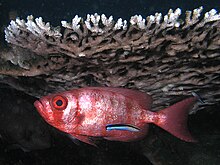
Advertising coloration can signal the services an animal offers to other animals. These may be of the same species, as in sexual selection, or of different species, as in cleaning symbiosis. Signals, which often combine colour and movement, may be understood by many different species; for example, the cleaning stations of the banded coral shrimp Stenopus hispidus are visited by different species of fish, and even by reptiles such as hawksbill sea turtles.[23][24][25]
Sexual selection
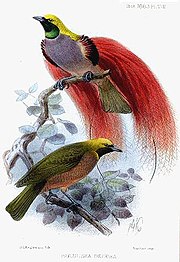
Darwin observed that the males of some species, such as birds-of-paradise, were very different from the females.
Darwin explained such male-female differences in his theory of sexual selection in his book
Different forms of sexual selection are possible, including rivalry among males, and selection of females by males.
Warning

Warning coloration (aposematism) is effectively the "opposite" of camouflage, and a special case of advertising. Its function is to make the animal, for example a wasp or a coral snake, highly conspicuous to potential predators, so that it is noticed, remembered, and then avoided. As Peter Forbes observes, "Human warning signs employ the same colours – red, yellow, black, and white – that nature uses to advertise dangerous creatures."[28] Warning colours work by being associated by potential predators with something that makes the warning coloured animal unpleasant or dangerous.[29] This can be achieved in several ways, by being any combination of:
- distasteful, for example caterpillars, pupae and adults of the starlings vomit.[31]
- foul-smelling, for example the skunk can eject a liquid with a long-lasting and powerful odour[32]
- aggressive and able to defend itself, for example honey badgers.[33]
- venomous, for example a viper or coral snake can deliver a fatal bite.[28]
Warning coloration can succeed either through inborn behaviour (
Mimicry
Mimicry means that one species of animal resembles another species closely enough to deceive predators. To evolve, the mimicked species must have warning coloration, because appearing to be bitter-tasting or dangerous gives natural selection something to work on. Once a species has a slight, chance, resemblance to a warning coloured species, natural selection can drive its colours and patterns towards more perfect mimicry. There are numerous possible mechanisms, of which the best known are:
- bees.
- wasps and bees (hymenoptera).
Batesian mimicry was first described by the pioneering naturalist
Müllerian mimicry was first described by the pioneering naturalist Fritz Müller. When a distasteful animal comes to resemble a more common distasteful animal, natural selection favours individuals that even very slightly better resemble the target. For example, many species of stinging wasp and bee are similarly coloured black and yellow. Müller's explanation of the mechanism for this was one of the first uses of mathematics in biology. He argued that a predator, such as a young bird, must attack at least one insect, say a wasp, to learn that the black and yellow colours mean a stinging insect. If bees were differently coloured, the young bird would have to attack one of them also. But when bees and wasps resemble each other, the young bird need only attack one from the whole group to learn to avoid all of them. So, fewer bees are attacked if they mimic wasps; the same applies to wasps that mimic bees. The result is mutual resemblance for mutual protection.[39]
Distraction
Startle
Some animals such as many
Motion dazzle
Some prey animals such as zebra are marked with high-contrast patterns which possibly help to confuse their predators, such as lions, during a chase. The bold stripes of a herd of running zebra have been claimed make it difficult for predators to estimate the prey's speed and direction accurately, or to identify individual animals, giving the prey an improved chance of escape.[42] Since dazzle patterns (such as the zebra's stripes) make animals harder to catch when moving, but easier to detect when stationary, there is an evolutionary trade-off between dazzle and camouflage.[42] There is evidence that the zebra's stripes could provide some protection from flies and biting insects.[43]
Physical protection
Many animals have dark pigments such as melanin in their skin, eyes and fur to protect themselves against sunburn[44] (damage to living tissues caused by ultraviolet light).[45][46] Another example of photoprotective pigments are the GFP-like proteins in some corals.[47] In some jellyfish, rhizostomins have also been hypothesized to protect against ultraviolet damage.[48]
Temperature regulation
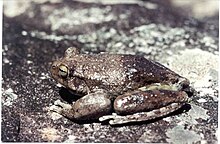
Some frogs such as Bokermannohyla alvarengai, which basks in sunlight, lighten their skin colour when hot (and darkens when cold), making their skin reflect more heat and so avoid overheating.[49]
Incidental coloration
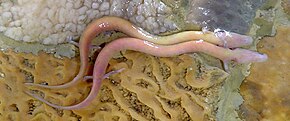
Some animals are coloured purely incidentally because their blood contains pigments. For example, amphibians like the
Mechanisms of colour production in animals
Animal coloration may be the result of any combination of
Coloration by pigments

Pigments are coloured chemicals (such as
Variable coloration by chromatophores

Chromatophores are special pigment-containing cells that may change their size, but more often retain their original size but allow the pigment within them to become redistributed, thus varying the colour and pattern of the animal. Chromatophores may respond to hormonal and/or neurobal control mechanisms, but direst responses to stimulation by visible light, UV-radiation, temperature, pH-changes, chemicals, etc. have also been documented.[1] The voluntary control of chromatophores is known as metachrosis.[52] For example, cuttlefish and chameleons can rapidly change their appearance, both for camouflage and for signalling, as Aristotle first noted over 2000 years ago:[2]
The octopus ... seeks its prey by so changing its colour as to render it like the colour of the stones adjacent to it; it does so also when alarmed.
— Aristotle

When
Structural coloration

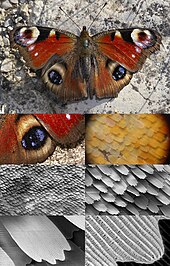
While many animals are unable to synthesize carotenoid pigments to create red and yellow surfaces, the green and blue colours of bird feathers and insect carapaces are usually not produced by pigments at all, but by structural coloration.
| Mechanism | Structure | Example |
|---|---|---|
| Diffraction grating | layers of chitin and air | Iridescent colours of butterfly wing scales, peacock feathers[55] |
| Diffraction grating | tree-shaped arrays of chitin | Morpho butterfly wing scales[55] |
| Selective mirrors | micron-sized dimples lined with chitin layers | Papilio palinurus, emerald swallowtail butterfly wing scales[55]
|
| Photonic crystals | arrays of nano-sized holes | Cattleheart butterfly wing scales[55]
|
| Crystal fibres | hexagonal arrays of hollow nanofibres | Aphrodita, sea mouse spines[55]
|
| Deformed matrices | random nanochannels in spongelike keratin | Diffuse non-iridescent blue of Ara ararauna, blue-and-yellow macaw[55] |
| Reversible proteins | reflectin proteins controlled by electric charge | Iridophore cells in Doryteuthis pealeii squid skin[55]
|
Bioluminescence
Bioluminescence is the production of
See also
- Albinism in biology
- Chromatophore
- Dog coat colours and patterns
- Cat coat genetics
- Deception in animals
- Equine coat colour
- Equine coat colour genetics
- Roan (colour)
- Fish coloration
References
- ^ a b Meyer-Rochow, VB (2001). Fish chromatophores as sensors of environmental stimuli - Book=Sensory Biology of Jawed Fishes; editors Kapoor BG & Hara TJ; Science Publishers Enfield (NH), USA. pp. 317–334.
- ^
- ^ a b Hooke, Robert (1665) Micrographia. Ch. 36 ('Observ. XXXVI. Of Peacoks, Ducks, and Other Feathers of Changeable Colours.'). J. Martyn and J. Allestry, London. Full text .
- ^ a b Darwin, Charles (1859). On the Origin of Species, Ch. 4. John Murray, London. Reprinted 1985, Penguin Classics, Harmondsworth.
- ^ a b Bates, Henry Walter (1863). The Naturalist on the River Amazons. John Murray, London.
- ^ Mallet, James. "E.B. Poulton (1890)". University College London. Retrieved 23 November 2012.
- .
- ^ a b c Poulton, Edward Bagnall (1890). The Colours of Animals, their meaning and use, especially considered in the case of insects. Kegan Paul, Trench, Trübner. London. pp. 331–334
- ^ Beddard, Frank Evers (1892). Animal Coloration, An Account of the Principal Facts and Theories Relating to the Colours and Markings of Animals. Swan Sonnenschein, London.
- ^ Yost, Robinson M. "Poulton: Colours". Kirkwood Community College. Retrieved 5 February 2013.
- S2CID 3983153.
- ^ Thayer, Abbott Handerson and Thayer, Gerald H. (1909). Concealing-Coloration in the Animal Kingdom. New York.
- hdl:2246/470.
- ^ Cott, 1940.
- ^ Cott, 1940. p. 51
- ISBN 0-679-64288-9.
- ISBN 978-1-4733-7510-9.
- ISBN 978-1-139-49623-0.
- PMID 11481461.
- ^ a b c d e f Forbes, 2009. pp. 50–51
- ^ Cott, H. B. 1940
- ^ Forbes, 2009. pp. 72–73
- ISBN 978-962-209-027-9.
- ISBN 978-0-486-42068-4.
- hdl:11449/211785.
- The Descent of Man. Heinemann, London.
- ^ Miller, G. F. (2000). The Mating Mind: How sexual choice shaped the evolution of human nature. Heinemann, London.
- ^ a b Forbes, 2009. p. 52 and plate 24.
- ^ Cott, 1940. p. 250.
- PMID 28563638.
- ^ Forbes, 2008. p. 200.
- ^ Cott, 1940, p. 241, citing Gilbert White.
- ^ "Black, White and Stinky: Explaining Coloration in Skunks and Other Boldly coloured Animals". University of Massachusetts Amberst. 27 May 2011. Retrieved 21 March 2016.
- ^ .
- ^ Cott, 1940. pp. 277–278.
- ^ Cott, 1940. pp. 275–276.
- ^ Cott, 1940. p. 278.
- ^ Cott, 1940. pp. 279–289.
- ^ Forbes, 2009. pp. 39–42
- S2CID 24868603.
- ^ Edmunds, Malcolm (2012). "Deimatic Behavior". Springer. Retrieved 31 December 2012.
- ^ PMID 22117898.
- ^ Gill, Victoria (9 February 2012). "BBC nature". Zebra stripes evolved to keep biting flies at bay. Retrieved 30 April 2012.
- ^ World Health Organization, International Agency for Research on Cancer "Solar and ultraviolet radiation" IARC Monographs on the Evaluation of Carcinogenic Risks to Humans, Volume 55, November 1997.
- PMID 3707165.
- S2CID 36665467.
- PMID 25496144.
- ISSN 2296-7745.
- PMID 16547291.
- S2CID 28710659.
- ^ "colour Variations in Light and Dark Skin" (PDF). Prentice-Hall. 2007. Retrieved 27 November 2012.
- ^ a b c d Wallin, Margareta (2002). "Nature's Palette" (PDF). Nature's Palette: How Animals, Including Humans, Produce Colours. 1 (2). Bioscience-explained.org: 1–12. Retrieved 17 November 2011.
- ^ a b c d Hilton, B. Jr. (1996). "South Carolina Wildlife". Animal Colours. 43 (4). Hilton Pond Center: 10–15. Retrieved 26 November 2011.
- ^ Kozloff, Eugene N. (1983) Seashore Life of the Northern Pacific Coast: Illustrated Guide to Northern California, Oregon, Washington and British Columbia. University of Washington Press. 2nd edition.
- ^ a b c d e f g h i Ball, Philip (May 2012). "Nature's colour Tricks". Scientific American. pp. 60–65. Retrieved 23 April 2012.
- ISBN 9789812568014.
- ISSN 0276-8186. Archived from the originalon 14 July 2009. Retrieved 26 November 2011.
- S2CID 14523078. Archived from the original(PDF) on 16 May 2008. Retrieved 25 November 2011.
- ^ Widder, E. "Midwater Squid, Abralia veranyi". Smithsonian Ocean. Smithsonian National Museum of Natural History.
- ^ Piper, Ross. Extraordinary Animals: An Encyclopedia of Curious and Unusual Animals. Greenwood Press, 2007.
Sources
- Cott, Hugh Bamford (1940). Adaptive Coloration in Animals. Methuen, London.
- Forbes, Peter (2009). ISBN 0300178964
External links
- Theme issue 'Animal coloration: production, perception, function and application' (Royal Society)
- NatureWorks: Coloration (for children and teachers)
- HowStuffWorks: How Animal Camouflage Works
- University of British Columbia: Sexual Selection (a lecture for Zoology students)
- Nature's Palette: How animals, including humans, produce colours

